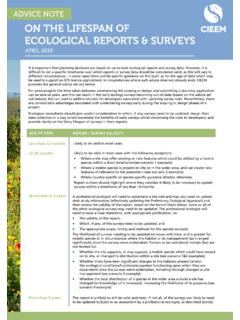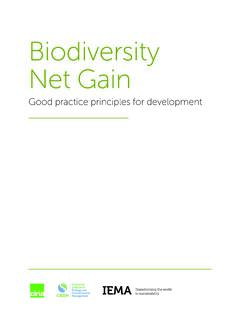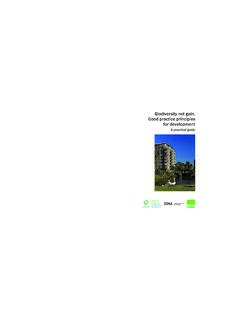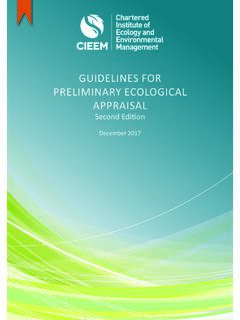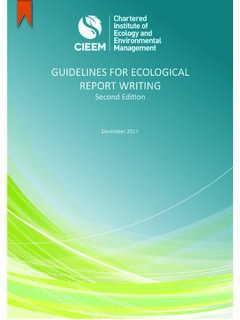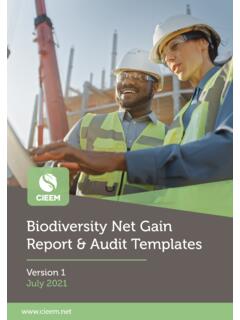Transcription of DMRB VOLUME 10 SECTION 4 PART 4 - HA 81/99 - NATURE ...
1 DESIGN MANUAL FOR ROADS AND BRIDGES. VOLUME 10 ENVIRONMENTAL. DESIGN AND. MANAGEMENT. SECTION 4 NATURE conservation . PART 4. HA 81/99 . NATURE conservation ADVICE IN. RELATION TO OTTERS. SUMMARY. This Advice Note gives advice in relation to otters and other mammals. INSTRUCTIONS FOR USE. 1. Remove HA 81/99 from VOLUME 10, SECTION 1, Part 9. 2. Insert HA 81/99 , with new title page, into VOLUME 10, SECTION 4, Part 4. 3. Archive this sheet as appropriate. Note: A quarterly index with a full set of VOLUME Contents Pages is available separately from the Stationery Office Ltd. February 2001. DESIGN MANUAL FOR ROADS AND BRIDGES HA 81/99 . THE HIGHWAYS AGENCY. THE SCOTTISH EXECUTIVE DEVELOPMENT. DEPARTMENT. THE NATIONAL ASSEMBLY FOR WALES. CYNULLIAD CENEDLAETHOL CYMRU. THE DEPARTMENT FOR REGIONAL DEVELOPMENT*.
2 NATURE conservation Advice in Relation to Otters * A Government Department in Northern Ireland Summary: This Advice Note gives advice in relation to otters and other mammals. VOLUME 10 SECTION 1. Part 9 HA 81/99 Registration of Amendments REGISTRATION OF AMENDMENTS. Amend Page No Signature & Date of Amend Page No Signature & Date of No incorporation of No incorporation of amendments amendments May 1999 ELECTRONIC COPY NOT FOR USE OUTSIDE THE AGENCY. PAPER COPIES OF THIS ELECTRONIC DOCUMENT ARE UNCONTROLLED. VOLUME 10 SECTION 1. Registration of Amendments Part 9 HA 81/99 . REGISTRATION OF AMENDMENTS. Amend Page No Signature & Date of Amend Page No Signature & Date of No incorporation of No incorporation of amendments amendments ELECTRONIC COPY NOT FOR USE OUTSIDE THE AGENCY. May 1999.
3 PAPER COPIES OF THIS ELECTRONIC DOCUMENT ARE UNCONTROLLED. DESIGN MANUAL FOR ROADS AND BRIDGES. VOLUME 10 ENVIRONMENTAL. DESIGN. SECTION 1 THE GOOD ROADS. GUIDE - NEW ROADS. PART 9. HA 81/99 . THE GOOD ROADS GUIDE. NEW ROADS. NATURE conservation ADVICE IN. RELATION TO OTTERS. Contents Chapter 1. Introduction 2. Key issues 3. Protection status 4. General characteristics 5. Habitat 6. Mortality 7. Otter surveys 8. Possible effects on otters 9. Existing roads 10. Mitigation measures 11. Disruption during construction 12. Contract implementation 13. Post construction monitoring Annex A Summary of legislation regarding otters Annex B Habitats listed in the Biodiversity Steering Group Report (1995) directly affecting otters Annex C Government and statutory organisations Annex D Bibliography and acknowledgements May 1999 ELECTRONIC COPY NOT FOR USE OUTSIDE THE AGENCY.
4 PAPER COPIES OF THIS ELECTRONIC DOCUMENT ARE UNCONTROLLED. VOLUME 10 SECTION 1. DESIGN MANUAL FOR ROADS AND BRIDGES. Part 9 HA 81/99 . also requires the retention of suitable banks for burrowing and vegetation for food. 1. INTRODUCTION Various species of birds and fish will also benefit if the water course is left undisturbed or restored to a natural' condition. The otter (Lutra lutra) is one of Britain's most rare and elusive of mammals. Once established on river systems throughout the UK, it suffered a dramatic decline The advice notes presented in this chapter provides the range of mitigation during the 1950s, retreating to isolated populations in Scotland, Wales and South measures representing the best practice guidelines to date as recommended in a range West England. As a result of improving water quality, strategic conservation efforts of situations, and explains the correct use and positioning of them, as far as is and sensitive river management, along with a successful release programme, the otter possible for a generalised case.
5 These guidelines are not intended as a substitute for is returning to much of its former range. They can now be found in all 8 credible mitigation advice based on experience and tailored to each individual Environment Agency regions (Strachan and Jefferies, 1996) and virtually the whole situation. It must be borne in mind that there is no general solution which covers all of Scotland (Green and Green, 1997). Otter populations have been in decline sites, and each location must be assessed individually by an expert in otter ecology to throughout Europe and the UK population is recognised as one of international provide an appropriate, effective suite of mitigation measures. importance. As a result, the otter is protected under UK and European law which is designed to conserve the animal and its habitats.
6 This advice note applies to schemes for new roads and to improvements to existing roads where they cross watercourses and wetlands that are a part of otter However, this increase in population has led to a sharp rise in otter road habitat. The upgrading, widening or repair of many roads currently in operation can casualties and such accidents account for 60% of violent deaths in the UK provide many opportunities for reducing otter casualties especially in areas where (Woodroffe, 1994). New road schemes and improvements to existing roads which do otter road kills have been reported. In order to reduce the effects of existing roads the not take the needs of otters into account in their design and construction could provision of mitigation should be considered whenever improvements or major seriously affect the successful re-colonisation of some areas as well as adversely maintenance works are planned.
7 Affecting existing populations. The problem of road casualties amongst otter populations has been targeted in both the Biodiversity Steering Group's Action Plans Mitigation of the effects of roads on otters is not just concerned with the (Biodiversity: The UK Steering Group Report, 1995) and the Joint NATURE conservation of the otter. Road safety is an important consideration and can be conservation Committee's (JNCC) document A Framework for Otter conservation improved by discouraging wild animals from crossing the carriageway. in the UK: 1995 - 2000 (JNCC, 1996) as requiring immediate attention. As a result of these reports, Government policy is to reduce and, where possible, eliminate It should be noted that all references to the relevant statutory bodies' apply possible threats to otter populations and these guidelines are a product of this policy.
8 Equally to English NATURE (EN), the Countryside Council for Wales (CCW), Scottish Careful design of road schemes can assist in the implementation of this policy. Natural Heritage (SNH) and the Environment and Heritage Service in Northern Ireland: Countryside and Wildlife (ES:CW) unless otherwise stated. The The general principles for mitigation described here may also be applied to Environment Agency (EA) have responsibility for environmental protection and for other mammals, eg badgers (see dmrb Chap 1). The conservation of promoting the enhancement of natural habitats within river catchment areas within riparian habitat for otters will also benefit other animals. The water vole (Arvicola England and Wales. They should be consulted on all proposals affecting terrestris) is another species listed on Schedule 5 of the Wildlife and Countryside Act watercourses or wetlands.
9 This role is filled by the Scottish Environmental Protection (1981) and is also included in the Biodiversity Steering Group report. This species Agency (SEPA) in Scotland. May 1999 ELECTRONIC COPY NOT FOR USE OUTSIDE THE AGENCY. 1. PAPER COPIES OF THIS ELECTRONIC DOCUMENT ARE UNCONTROLLED. VOLUME 10 SECTION 1. Part 9 HA 81/99 . Survey work for otters should be completed as part of the environmental 2. KEY ISSUES assessment process for all new schemes and improvements to existing roads. Otters should be considered in the design, construction and maintenance of all Surveys of the area for signs of otters and important habitat features, eg new roads that will affect the species habitat. resting sites and breeding areas, should begin at an early stage in the design process and these surveys should be repeated every 3 months over the course Mitigation for the effects of existing roads should always be considered when of one year during the consultation and construction process.
10 Improvements or major maintenance works are planned adjacent to water courses. Competent assessment work is critical to the success of any mitigation efforts. All surveys should be conducted by experts in otter ecology and survey It is important to recognise any water course, water body or wetland as a techniques. habitat and wildlife corridor and that all these areas have potential as otter habitat. It is also important not to create barriers to the re-colonisation of Any recommendations and designs proposed must not be altered without habitat by otter populations. discussion with the consultant. English NATURE (or the equivalent statutory body in Scotland, Wales and Fencing will require inspection every 6 months during the life span of the road Northern Ireland) should always be consulted where otter habitat is likely to to ensure no weak points have developed, as breaches in the fence can negate be affected.
